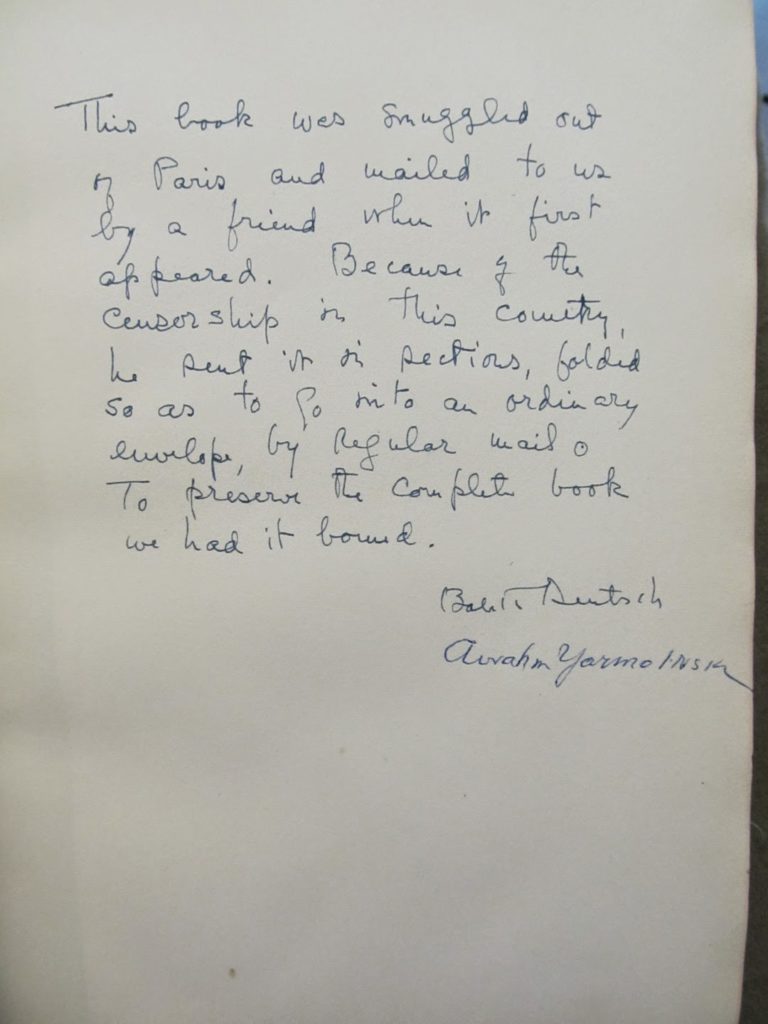Bloomsday is almost here!
Although Bloomsday itself is Monday, June 16, at the Rosenbach and the Free Library we’re celebrating from now through next Wednesday, with a great slate of programs. One of them is an author talk on 6/18 at the Free Library by Kevin Birmingham, author of The Most Dangerous Book: The Battle for James Joyce’s Ulysses.
As its title indicates, Birmingham’s book addresses the censorship controversies Ulysses faced. In 1920 the book’s publishers were arrested for violating Post Office laws about the circulation of obscene material. At the trial in 1921, a panel of judges decided that the Nausicaa episode was in fact obscene and therefore violated the Post Office’s Comstock laws.
One of our first editions of Ulysses from 1922 speaks to the inability to legally send Ulysses through the mail.
 |
|
James Joyce
(1882-1941), Ulysses. Paris: Shakespeare & Company, 1922 EL4 J89ul 922a |
The inscription notes, “This book was smuggled out of Paris and mailed to us when it first appeared. Because of the censorship in this country he sent it in sections, folded so as to go into an ordinary envelope by regular mail.”
On some pages the creases caused by the deceptive mailing are still evident–note the vertical crease on the section shown here.
 |
|
James Joyce
(1882-1941), Ulysses. Paris: Shakespeare & Company, 1922 EL4 J89ul 922a |
The Ulysses ban was eventually overturned in 1933, However, Ulysses and other obscene material were not the only things banned from the mail in the early 1920s. In looking at one of the “today in history” sites, I found the tidbit that on June 13, 1920 the U.S. Post Office Department “rule[d] that children could not be sent through parcel post.”
I was immediately a bit skeptical, but it turns out that after the advent of Parcel Post in 1913 there were several instances of people sending their children (under the 50 lb postal weight limit) by mail. This wasn’t so much a case of parents popping their children in boxes and dropping them in a mail box, but instead of entrusting them to postal employees and paying postage for their transit. There’s a great blog post from the Smithsonian’s Postal Museum, which goes into various known cases, including a girl who was mailed by train from Pensacola, Florida, to Christianburg, Virginia.
The Postal Museum blog notes that in 1914 the Postmaster General barred the mailing of humans, but it continued anyway. It suggests that the last case of child mailing was in 1915, but another blog reproduces a 1918 newspaper article about a recent trip by 2 girls, so it seems to have continued sporadically. I haven’t been able to track down exactly what the details were of the June 13, 1920 ban, although perhaps it was just an attempt to reiterate the earlier rules in the face of violations. Any further information or citations would be gratefully received!
In any case, in the 1920s you couldn’t send Ulysses through the mail; you couldn’t send a child through the mail, and you certainly couldn’t send a child reading Ulysses through the mail. But both Ulysses and children are most welcome at our Bloomsday celebration on Monday (as are any postal workers who care to stop in) so please join us.

Kathy Haas is the Associate Curator at The Rosenbach of the Free Library of Philadelphia and the primary poster at the Rosen-blog.
